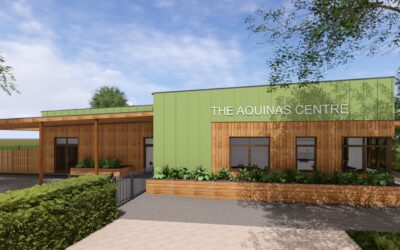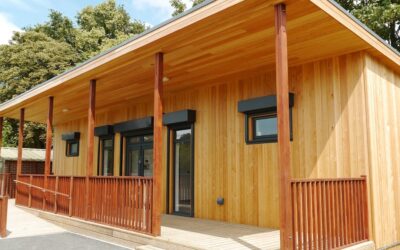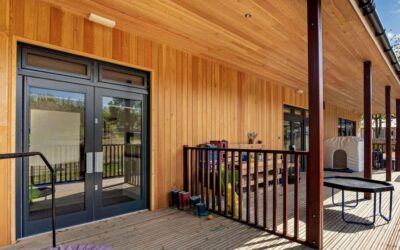TG Escapes Blog
The Power of Biophilic Design Within Education
Pupils today face a wealth of issues, from mental and physical health problems, to complex SEND needs. As designers and producers of modular school buildings across the UK, we are finding increasing demand for positive environments that uplift students and staff, underpinned by biophilic design principles.
Emphasising a connection to nature through several key factors, biophilic design helps to improve mood, reduce stress, and even boost exam results.
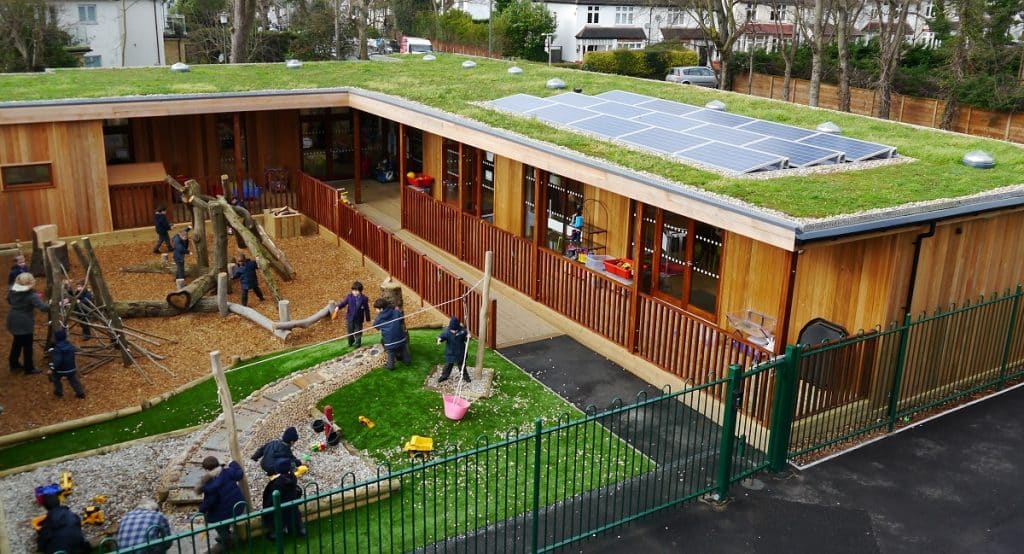
What is Biophilic Design?
Biophilic design refers to a series of architectural principles that connect occupants more closely to nature. The term was first coined by American biologist E.O. Wilson in his 1984 book “Biophilia”, when he proposed that humans possess an innate affinity towards nature, suggesting that we feel more relaxed, productive, and fundamentally healthier when surrounded by elements echoing the natural world that humans evolved to live in.
More recently, biophilic design has gained popularity as a way to improve well-being in buildings, with designers looking to take inspiration from the visuals and patterns of nature. This could mean using natural materials like wood and stone, incorporating organic shapes and textures, maximising natural light, providing access to outdoor spaces, and incorporating views of nature. Our team have long been interested in the benefits of this approach, and today it forms a key aspect of our design process.
The Importance of Designing For Biophilia From the Ground Up
We first recognised the benefits of biophilia over 20 years ago as a manufacturer of smaller garden rooms and offices, with their timber construction and views of nature providing a more positive environment for our clients to work or relax in. When looking to harness the benefits of biophilia, you can supplement an existing building with things like plants, images of nature, and superior ventilation, but to achieve the full impact, biophilia is something that should be incorporated from the very start.

“The principle of biophilic design is about connecting occupants with nature. At the simplest level, this is about natural light and views out to nature. All our buildings are designed with the maximum amount of natural light and access to the outdoors. Whenever possible, we want every room to have access to decking.” – Mark
While we’ve been shouting from the rooftops about biophilia for many years, we’re pleased to see it finally gaining traction within the industry, with several consultants and clients specifically approaching us because of our biophilic approach. Particularly for SEND and SEMH needs, the benefits offered by a tailored biophilic space can be massive. For our team, it’s not just about meeting a client’s brief, but about creating an uplifting space for users.
What Makes up A Biophilic Classroom?

The principles of a biophilic building or room involve incorporating views of nature, access to nature, and high levels of natural light and ventilation. This is achieved through a series of design decisions, additions to buildings, and material choices:
- Abundant natural light: Seek to maximise sun exposure through expansive windows, glass walls, skylights, and sun pipes, allowing a classroom to rely on natural light whenever possible.
- Access to the outdoors: Easy access to the outdoors should be prioritised within the initial design, with our team aiming for all classrooms to have easy access to decking.
- Views of nature: We design our buildings to offer fantastic views of gardens, trees, and skylines from each room. This approach helps to reduce stress and mental fatigue.
- Ventilation: MVHR (Mechanical Ventilation and Heat Recovery) technology can be used to ensure clean, fresh air is continually circulated around our school buildings. This system also aids energy efficiency by reducing heat loss, and also helps reduce the risk of infection.
- Sustainably sourced timber: Our buildings are constructed around timber frames and panels, with all wood sourced sustainably from carefully managed forests. As a natural material, timber buildings provide a truly different feel to users.
- Murals: Images of nature and natural patterns can also bring biophilic benefits to a school building. Our team have incorporated murals into projects where direct views of nature are not available.
- Living roofs: Living roofs, sometimes called green roofs or sedum roofs, offer both sustainability benefits and additional views of nature within a school building.
- Exterior walkways: Whenever possible, we look to connect buildings through exterior walkways rather than corridors. These covered spaces ensure regular access to the outdoors throughout the school day.
- Outdoor classrooms: Outdoor classrooms offer fantastic exposure to nature, and can be built with coverings for all-weather use.
- Wildlife habitats: We provide bird and bat boxes alongside insect hotels to improve the biodiversity of the school environment and better connect students with nature.
Collectedly, these elements can provide a profound boost to staff and students, creating uplifting and focused educational spaces for standard classrooms and tailored SEND environments.
The Numerous Benefits of Biophilia
Biophilia offers clear benefits within all buildings, but can be especially crucial within schools. Considering the many challenges faced by modern children, and the need to hold their engagement throughout the school day, the cumulative impact of natural light, visual elements, and high air quality can help to lower the stress of pupils, improve their concentration and focus, and inspire their creativity. For students with SEND or SEMH needs this can be even more important, offering an environment that feels safe, comfortable, and calming. In time, the impact of biophilia can lead to higher attendance and improved exam results.

“I think the general mental health crisis has made people look harder into things that can be done to help address that. And I think biophilic design is popping up on people’s radar because connecting to nature is something everybody knows is going to be good for people.” – Mark
While our clients don’t always make a direct connection to biophilic design, across the feedback we’ve received there are many references to the positive nature of our spaces, the level of light they offer, and the ways in which pupils and teachers alike enjoy being in them.
- “I think that there is a difference in attitude working in an environment that is good for learning. I can certainly see that because they have got the space, the light. It is a little bit early to tell but, because it’s not crowded and they’re not on top of each other, I would say that certainly in behavioural terms in the classes themselves there has been a positive influence.” Luanda Stannard, Head of English
- “The more organic materials, particularly the timber, does link in with the biophilic agenda that we want to embrace. The doors that open out onto nature and the greenness of the space cuts away from the institutional feel that you want to avoid. It informalises the learning environment, which is nice.” Pete Trumper, School Organisation and Capital Specialist
The Science Backing Us Up
Over recent years, a wealth of studies have emerged backing up the central tenets of biophilic design as beneficial to the occupants of a building, including within educational environments.
- A 2014 study found that “This collected evidence leads us to deduce that good biophilic design could have a number of positive impacts. Some of these include enhancing productivity and performance and have a positive impact on attention restoration and stress reduction”.
- A 2021 study looked at the impact of natural fractal patterns within built spaces, concluding “These natural patterns have the opportunity to decrease eye-strain, headache rates, and stress in a large percentage of viewers”.
- A 2015 study on natural light in classrooms stated that “our findings suggest that classroom characteristics associated with daylighting do significantly impact the performance of the schoolchildren and may account for more than 20% of the variation between performance test scores. The window-to-floor area ratio in the classroom appears to have the largest effect, indicating that larger window areas are advantageous.”
Some Examples of Biophilic Design in Educational Projects
Biophilic design is a key principle underpinning our buildings, alongside our commitments to sustainable materials and achieving net zero in operation. Here are just two examples of how we’ve created uplifting nature-based learning environments:
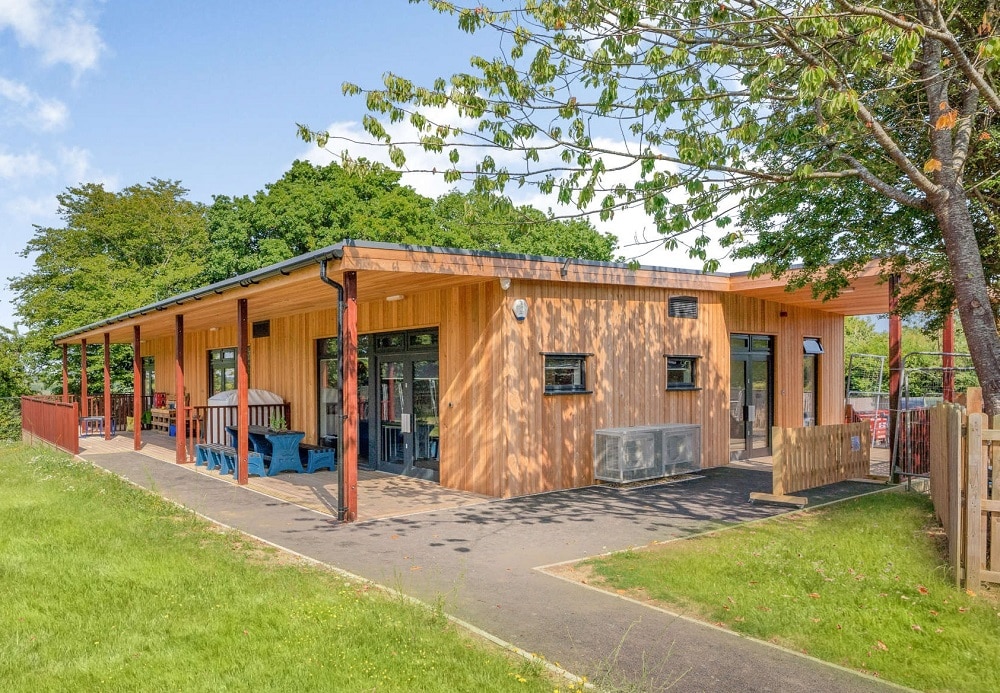
One of our recent projects involved creating an Eco Building for complex SEMH needs at Mountfield Heath School. Containing 2 classrooms, 2 therapeutic intervention spaces, a sensory room, and a small kitchen, we prioritised ample natural light, high ceilings, adaptive ventilation and quality acoustics. Exterior decking ensured quick access to the outdoors, while the natural timber aesthetic seamlessly fitted within the surrounding woodland area. The result is a beautiful space loved by children and staff alike.
A favourite biophilic project from our team is the nursery we built at Bickley Park School, adding 3 classrooms with ample interior and exterior spaces. We emphasised natural light throughout with large windows and sun pipes, while solar panels and a living roof helped achieve excellent levels of energy efficiency. Bickley Park was so pleased with our work that we collaborated again on a building for older pupils.
In recent years our team have also been hard at work on the next stage, taking the principles of biophilia and applying them to an entire school.
Building a Biophilic School
TG Escapes took home “Public Sector Innovation of the Year” at the 2023 MMC Awards for our net-zero biophilic primary school concept, designed from the ground up to prioritise a connection to nature.
With separate classroom pavilions connected by covered outdoor walkways and courtyards, the school is built around a central landscaped area with an outdoor classroom. Abundant glazing, living roofs, and timber construction offer biophilic elements throughout the space, alongside fantastic levels of lighting, ventilation, and access to the outdoors. The school would also meet all sustainability targets, offering net zero in lifetime.
We believe that the educational spaces of the future should be built to support the mental and physical health of all students, especially those with SEND or SEMH needs. As we continue expanding our educational projects, we aim to integrate these immersive biophilic principles on an even larger scale.
Find out More About Our Work
TG Escapes is an award-winning modular building manufacturer, primarily operating in the education sector. We offer a turnkey process, designing, building, and installing across the UK. This streamlined service saves time and money for our clients while ensuring our commitments to quality, sustainability, and biophilic design are upheld.
Follow us to keep up to date with the latest developments, or speak to a member of our team to find out how we work with consultants and contractors across the UK.
About the author
More posts from our blog
Education Estates 2025: Surrey County Council Share Their SEND Provision Strategy, Including the Contribution Made by TG Escapes
At the recent Education Estates 2025 conference, I was proud to join Euan Leslie, Programme Manager for our partners Surrey County Council as we presented their ambitious and highly successful strategy for expanding Special Educational Needs and Disabilities (SEND)...
Supporting Active School Life With Modular Sports Pavilions
Physical activity is a crucial part of everyday schooling across the UK. But in many settings, ageing facilities and limited space can prevent pupils from getting the full benefit of PE, sport, and outdoor recreation. Modern sports and leisure pavilions offer an...
Creating Calm, Purposeful Spaces for SEMH Learners
For students with Social, Emotional, and Mental Health (SEMH) needs, the right environment can make a world of difference. In an ideal setting, buildings are a key part of the therapeutic process, shaping behaviour, supporting emotional regulation, and helping...

